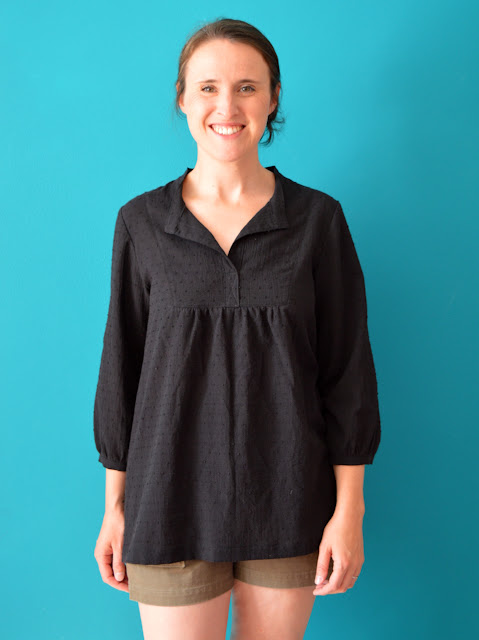Yet I really wanted to get this fine swiss dot cotton from Fabric Godmother (the black is currently out of stock but it is still available in navy, red, white, pale blue and blush) out of my stash and into my wardrobe. So I reached for my trusted, well-used and thoroughly tweaked copy of the Wiksten Tova top/dress pattern. I have lost count of how many garments I have made using this pattern to date, but I basically replicated my much-loved washed denim version (which has now been demoted to allotment wear only).

I veered away from the denim version just a smidge with the tiny addition of this criss-cross stitching at the base of the placket (pictured above) so I can wear this top without a camisole underneath, should I desire. (And during this past summer, I have desired.) For my previous versions of this pattern I have added poppers or buttons/buttonholes to the placket to stop it gaping open too much, however I like this stitching way more as a solution.
As you can imagine, this top instantly found itself in regular rotation in my wardrobe, as only a black version of your favourite sewing pattern could. I've worn it heaps with these Lander shorts and my Cobra corsage Luna pants, and now that the weather is turning nippy, I'm excited to try some new outfit combos with a vest layered underneath.
Because I have already blogged about the Tova pattern multiple times, I was tempted not to bother sharing this top at all. However, this project signifies the end (kind of) of my #2018makenine plan/challenge. Let's see how that went....
My original set of plans:
And here's what became of those plans:
1) The cocoon coat was a major success.
2) I have yet to make the full length Lander pants as I intended, however the wearable-toile shorts version came out better than I hoped and saw MASSES of wear.
3) The Burdastyle oversized cardigan pattern plan was a flop, but this Kinder cardigan rose out from its ashes, and I wear it almost daily.
4) My version of the Ivy pinafore didn't fit exactly as I'd hoped, which was my fault for not toiling first, however I've still worn it numerous times during colder weather.
5) I made two new Dolores batwing tops and the long sleeved white/burgundy striped one in particular has been worn SO MUCH.
6) The Suzon pattern got a double airing, and both times I paired it with fancy Atelier Brunette fabric. I love both, but I thought the 3/4 sleeve one would be my favourite. However, it's the sleeveless one that has seen the most wear.
7) Even though we experienced a climate change-induced heat wave this summer that lasted several months, in the end I ran out of warm days to warrant making the Chataigne shorts this year. I got as far as tracing the pattern pieces and making a toile (see? I'm learning!), however my toile showed me I would need to go back and trace a couple of sizes smaller (I'm going to use a fabric with a little stretch), and I dragged my heels until it was too late to bother continuing. I do have the fabric, thread and zip gathered though, so I'll roll over this plan to next year.
8) The Matcha top became the Tova top (see top of this post!).
9) I went on a fitting odyssey with the Gemma tank pattern that resulted in a couple of wearable tops (and many toiles that were left in its wake!).
This was my first year of participating in the make nine challenge and creating a grid of project plans for the upcoming year. I went into it fully embracing the philosophy behind the initial idea: that it's a gentle guide to kickstarting your sewjo at the beginning of a new year, and shouldn't be viewed as a strict blueprint that you must stick to or else. Yet, I'm surprised by how many of the plans I laid out many months ago I did actually bring to fruition. I guess now would be a suitable time to admit that I did actually go back and revise my grid a couple of days after making my first after having a thorough hunt through my fabric and pattern stashes. So perhaps this revision helped me to make some really sound and suitable plans that I really wanted to stick to, months after the initial ideas. But I also like how this type of planning completely leaves room for other, more spontaneous projects ideas to jump to the top of your 'to make' list. I guess this type of planning endeavour is only going to be as strong as your initial plans, so if you know yourself, your style, your lifestyle and what suits you well, then you're more likely to have made great plans that you don't feel like abandoning six months later. I'm excited to do this again next year, and I have an idea for a slightly different approach that I'm looking forward to working on.
What about you? Have you created a make nine grid of plans before? How many of those plans did you actually end up making? What impact did it have on your creativity and/or productivity? Do you even see any worth in making such a plan at the start of a year anyhow? Enquiring minds (well, my mind at least) need to know...















